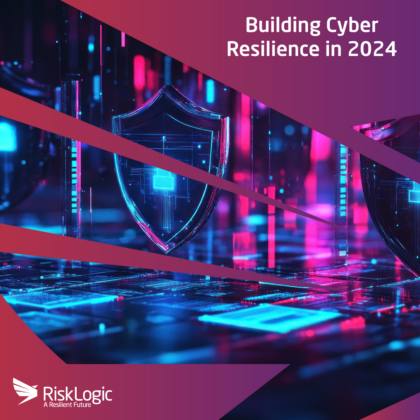-
Url copied to clipboard.
Within a digitally powered landscape, the labyrinth of cyber threats grows more potent and pervasive by the second for organisations. The evolving focus on cyber resilience management is meant to protect businesses from the potentially devastating consequences of cybercrime.
Cyber resilience is a rapidly evolving factor of organisation resilience that advocates for the capability to bounce back from cyber incidents swiftly and efficiently. It emphasises building an organisations ability to continue operations even during a breach while working towards full recovery. This resilience involves a detailed plan to respond to incidents, mitigating their impact, and restoring normal operations as quickly as possible.
Threats Faced by Modern Organisations
Earlier, standard security protocols were deemed sufficient, but an evolution in threats necessitates dynamic, end-to-end responses.
These threats range from internal data breaches, malware attacks, phishing, and ransomware, to state-sponsored cybercrime and Advanced Persistent Threats. They wreak havoc not just by disrupting operations, but by stealing valuable intellectual property and sensitive data, damaging brand image, and eroding customer trust.
Read below for some additional information about these threats:
- Internal Data Breaches: Often overlooked, internal data breaches – intentional or unintentional – can be as devastating as external attacks. These breaches could result from internal negligence, misconduct, or from a lack of adequate security measures and protocols.
- Malware Attacks: One of the most common cyber threats, malware refers to any malicious software used by cybercriminals to disrupt operations, gather sensitive information, or gain access to private networks. Variants include viruses, worms, spyware, and ransomware.
- Phishing Attempts: These attacks usually take the form of deceptive emails, text messages or websites that trick individuals into revealing sensitive information like passwords or credit card numbers. Sophisticated phishing techniques can even make convincing replicas of legitimate websites or emails from trusted sources.
- Ransomware: A potent form of malware, ransomware attacks encrypt a victim’s files, with the attackers demanding a ransom in return for the decryption key. Without compensation, the encrypted data is lost permanently.
- State-Sponsored Cybercrime: This involves cyberattacks initiated by a state or a state-sponsored group, often targeting critical infrastructure, economic assets, or government organisations of another nation.
- Advanced Persistent Threats (APTs): These are complex, stealthy, and prolonged threats usually driven by an intent of espionage or sabotage. Here, the attacker gains access to a network and stays undetected for an extended period.
All these developing threats call for a robust and dynamic approach to cyber resilience. Shifting from a defensive model focused solely on protection, to a more comprehensive and adaptive model that includes detection, response, recovery, and learning from cyber incidents.
What Cyber Resilience Involves
Under cyber resilience management, businesses prioritise the preservation of their critical functions through efficient incident response plans and robust data backup strategies, ensuring minimum disruption when a threat materialises.
Cyber resilience involves a multi-layered, strategic approach which encapsulates various elements:
- Threat Intelligence: Identifying potential threats and monitoring the cyber landscape is a fundamental step towards cyber resilience. Cyber threat intelligence helps in proactive detection, mitigation, and prevention of breaches, making organisations better prepared for potential attacks.
- Incident Response Plans: It is critical to have an effective incident response plan detailing the steps to be taken in the event of a cyber-attack. This plan should cover identification of the threat, containment of the breach, removal of the threat, and recovery of systems and data to bring operations back to a baseline of normalcy.
- Regular Data Backup: A robust and consistent data backup strategy is a crucial part of resilience. Regular backups ensure that an organisation can quickly recover and restore its normal functions after a cyber-attack – particularly in cases of ransomware attacks. Sensitive information should be stored in secure, off-site locations, and data integrity should be routinely checked.
- Advanced Technologies: Incorporating advanced technologies can bolster an organisation’s resilience. These technologies can automate security systems, detect potential threats, mitigate breaches, and enhance response times.
- Awareness and Training: Educating employees on cybersecurity best practices reduces the risk of internal breaches and helps in the early detection of external threats. Regular training sessions can keep the workforce updated on the evolving threat landscape and mould a culture of cyber awareness. You can learn more about RiskLogic’s cyber resilience management training and programs here.
- Vulnerability Management: Regularly scanning networks and systems for vulnerabilities and promptly patching them is another key aspect of cyber resilience. Untreated vulnerabilities can serve as entry points for attackers.
- Compliance and Regulation: Compliance with data protection and cybersecurity regulations add an extra layer of protection. Besides avoiding financial penalties, compliance ensures maintaining necessary security standards.
- Collaboration: It involves partnering with external cyber resilience experts that can provide professional advice and expertise, monitor threats, and assist in incident response.
- Recovery Strategies: After addressing the threat, attention needs to be shifted towards restoring operations, assessing damage, and implementing measures to prevent future attacks. Post-incident analysis can provide valuable insights to strengthen the cyber resilience strategy.
Impact of Remote Work & Cloud Technologies
The push towards remote working has accelerated the importance of cyber resilience within organisations, not only to shield the digital systems but also to ensure continuity in crisis.
This shift to remote working has vastly broadened the attack surface for cybercriminals as individuals access organisational networks and sensitive data from various locations and devices, often from less secure home networks. This has increased the risk of data leaks, phishing attacks, and malware infections.
Similarly, the rise of cloud technologies brings about its own set of challenges, such as misconfigured cloud storage, insecure interfaces and APIs, and the shared security model. The virtual nature of the cloud also creates vulnerabilities that can be exploited if not properly managed and secured.
Organisations now face the daunting task of ensuring every endpoint – be it a laptop, smartphone, or tablet – complies with the necessary data security protocols. Education also becomes critical to defend against phishing and social engineering attacks. Regulations regarding the handling of sensitive data outside of the office environment must be stringently outlined and enforced.
The migration to cloud-based technologies also comes with an inherent set of risks that must be mitigated with comprehensive cyber resilience. Misconfigurations in the cloud can expose sensitive data and render systems vulnerable. It is the responsibility of the organisation to secure whatever they put in the cloud, including applications and data.
Moreover, measures around data backup and recovery become paramount in a cloud environment, as data loss could result from both system failures and cyberattacks. Hence, having a sophisticated disaster recovery plan becomes crucial to restoring normal operations with minimal downtime post an incident.
Finally, visibility and control over the cloud environment, while keeping pace with changing compliance requirements, needs continuous monitoring and updates. Tools that provide insights into cloud operations and enable real-time response to potential threats are necessary to maintain effective cyber resilience.
While the leaps toward remote working and cloud technologies bring unprecedented advantages in terms of efficiency and scalability, they also heighten the need for a strong cyber resilience strategy. This requires coordinated efforts across every facet of the organisation, coupled with advanced, adaptive technologies that ensure data integrity, privacy, and continued operations under all circumstances. As the landscape evolves, reaffirming the commitment to reliable and resilient cyber protection will be key to organisational success in the digitally connected future.
Consequences of Cyber-Attacks
High-profile breaches have resulted in significant financial losses, reputational damage, and even organisational closures. These incidents serve as critical reminders of the indispensability of cyber resilience management.
The following are a handful of possible consequences facing organisations as a result of poor cyber resilience in the face of a cyber-attack:
- Financial Losses: A cyberattack can impose severe financial consequences upon an organisation. These may stem from; costs associated with resolving the immediate impact of the attack, operational downtime, fines imposed due to non-compliance with data protection regulation, or loss of revenue due to customer doubts and attrition.
- Reputational Damage: Cyber breaches can provoke massive reputational harm to an organisation. In a digitally driven world, news of data breaches spreads quickly, causing customers, investors, and stakeholders to lose trust in the business. This loss of confidence can be catastrophic, often leading to a loss in market share or stock value, making recovery a monumental task. A recent example of this was the Optus data breach back in 2022.
- Customer Churn: Following a cyber breach, customers are likely to feel their data is not secure and might choose to take their business elsewhere. This loss of customers not only affects immediate revenue but also long-term customer loyalty and potential future earnings.
- Intellectual Property Theft: Cyberattacks often target and steal an organisations intellectual property, which includes anything from trade secrets to proprietary technology. This stolen information can end up in the hands of competitors or be put up for sale on the dark web.
- Legal Consequences: Depending on the severity of a breach and the nature of the exposed data, an organisation may face legal actions resulting in hefty fines, lawsuits, or regulatory penalties. For example, breaches involving personally identifiable information (PII) can lead to lawsuits claiming negligence.
Cyber resilience is not just an IT concern, but a business-wide imperative, with every employee playing their role in safeguarding the organisation against potential cyber threats.
Fostering a Resilient Culture
Organisations are recognising the importance of fostering a resilient culture among employees. The shift towards robust education, routine simulations, and reinforcement of safe cyber practices has cultivated an improved resilience posture across many businesses.
Creating a culture of cyber resilience goes beyond the IT department; it’s about instilling awareness and responsibility at every level of the organisation. As mentioned before, every individual plays a crucial role in protecting the organisation against cyber threats. Here are some ways companies are working on fostering such a culture:
- Cyber Resilience Education: It is imperative to keep employees informed and updated about the evolving cyber landscape. Regular training programs, workshops, and online training focusing on various cyber threats, potential vulnerabilities, and risk management techniques are becoming a norm in many organisations. Such training not only makes individuals aware of their role in maintaining cyber resilience but also emphasises the importance of vigilance and prompt action.
- Real-Time Simulations: Simulated cyber-attacks offer a practical and effective way to evaluate the organisation’s response mechanisms and gauge readiness.
- Safe Cyber Practices: Policies and guidelines regarding safe cyber practices need to be implemented and consistently enforced. These could include rules for password management, use of company devices and networks, handling sensitive data, and more.
- Incident Reporting: Implementing simplified and transparent processes for reporting and responding to cyber incidents ensures immediate action and reduces the likelihood of issues escalating.
- Learning from Incidents: When cyber incidents occur, they can offer valuable insights. Organisations are analysing these incidents, learning from the loopholes exploited, and taking corrective actions to improve their resilience against future breaches.
- Rewarding Responsible Behaviour: Incentivising individuals for responsible behaviour can further encourage engagement in cyber resilience. This could come in many forms, such as recognising individuals who report potential threats or successfully thwart attacks.
Fostering a resilient culture is not merely a necessity but a strategic imperative for businesses. It strengthens the human firewall, mitigates risks, and enables organisations to swiftly bounce back and thrive even in the face of adversity.
The Ever-Increasing Need for Cyber Resilience
The reality of the digital age is that cyber threats are inevitable. Despite the best efforts of organisations to avoid breaches, it’s only a matter of when, not if, they will experience a cyber-event. Cyber resilience comes into play by acknowledging this reality and preparing organisations not just to prevent, but to effectively respond, recover, and learn from these events.
The financial implications of cyber incidents are another driving force behind the growing necessity for cyber resilience. With the global cost of cybercrime projected to reach $10.5 trillion annually by 2025, the financial stakes have never been higher. Beyond the immediate costs of response and recovery, businesses also grapple with regulatory fines, potential litigation, reparations and the long-term effects on business valuation due to data breaches.
Moreover, regulatory bodies around the world are increasingly recognising the importance of cyber resilience. Compliance with burgeoning regulations can be immensely complex, but a well-executed cyber resilience strategy can enable organisations to meet these regulatory obligations more efficiently.
With the cyber landscape constantly changing and new threats emerging constantly and existing ones evolving, building cyber resilience allows organisations to stay a step ahead of these challenges. It is not a destination but a journey that demands continuous learning, adaptation, and improvement.
Contact RiskLogic to explore Cyber Resilience Management solutions









